Meet Our Available Puppies
Find the perfect ‘tail’ for your story!
The Puppy You've
Been Waiting For.
Product Title Here
Put a bird on it tumblr trust fund sustainable williamsburg green juice.
Product Title Here
Put a bird on it tumblr trust fund sustainable williamsburg green juice.
Product Title Here
Put a bird on it tumblr trust fund sustainable williamsburg green juice.
Product Title Here
Put a bird on it tumblr trust fund sustainable williamsburg green juice.
Product Title Here
Put a bird on it tumblr trust fund sustainable williamsburg green juice.
Product Title Here
Put a bird on it tumblr trust fund sustainable williamsburg green juice.
February 3, 2025
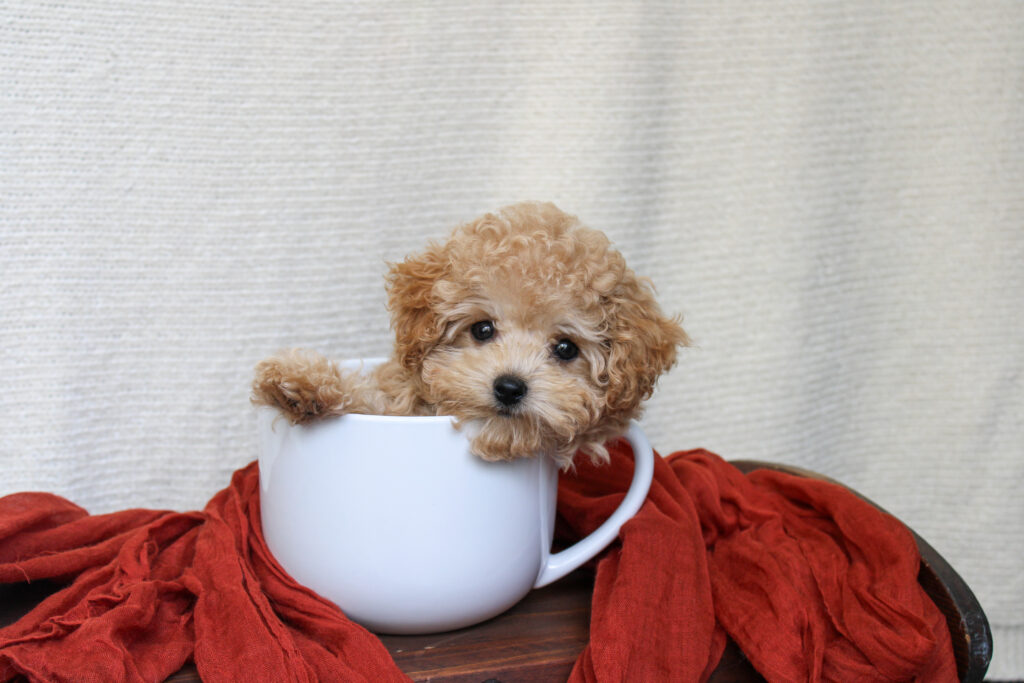
Teacup Maltipoos have captured the hearts of dog lovers worldwide. These tiny, affectionate companions bring joy with their playful personalities and adorable looks. But before bringing one home, it’s important to understand their needs, temperament, and care requirements.
In this guide, we’ll explore everything about Teacup Maltipoos, from their origins and size to training tips and health considerations. Whether you’re a first-time owner or an experienced dog lover, this article will help you decide if a Teacup Maltipoo is the right pet for you.
You can see our available Maltipoo and Cavapoo Puppies here https://storytaildogs.com/puppies-available
What Is a Teacup Maltipoo?
A Teacup Maltipoo is a miniature version of the Maltipoo, a designer breed that combines the Maltese and the Toy or Miniature Poodle. While standard Maltipoos typically weigh between 5 to 20 pounds, Teacup Maltipoos are much smaller. Most weigh between 3 to 5 pounds and stand just 6 to 9 inches tall at the shoulder.
These tiny dogs inherit the best qualities of both parent breeds. They have the gentle, affectionate nature of the Maltese and the intelligence of the Poodle. Their small size makes them perfect for apartment living, but their delicate build requires special care.
Are Teacup Maltipoos a Recognized Breed?
Since Teacup Maltipoos are a size variation rather than a separate breed, they are not officially recognized by major kennel clubs. However, their popularity continues to grow among dog lovers who want a tiny, hypoallergenic companion.
The Personality and Temperament of Teacup Maltipoo Puppies
Teacup Maltipoos may be small, but they have big personalities. These dogs are known for their affectionate and playful nature. They thrive on human interaction and enjoy being part of the family.
Loving and Loyal Companions
Teacup Maltipoos form strong bonds with their owners. They love to cuddle and often follow their people from room to room. Because of their deep attachment, they don’t do well when left alone for long periods. If you have a busy lifestyle, consider whether you can provide the attention they need.
Intelligent and Easy to Train
Poodles are one of the most intelligent dog breeds, and Maltipoos inherit that sharp mind. Teacup Maltipoos are quick learners and respond well to positive reinforcement training. Use treats, praise, and consistency to teach basic commands and house training.
Playful and Energetic Teacup Maltipoo Dogs
Despite their tiny size, Teacup Maltipoos have plenty of energy. They love to play and enjoy short walks, interactive toys, and games with their owners. Regular playtime keeps them happy and prevents boredom-related behavior problems.
Social and Friendly
Teacup Maltipoos generally get along well with people, other dogs, and even cats. They enjoy socializing but need early exposure to different environments, sounds, and experiences to become well-adjusted adults.
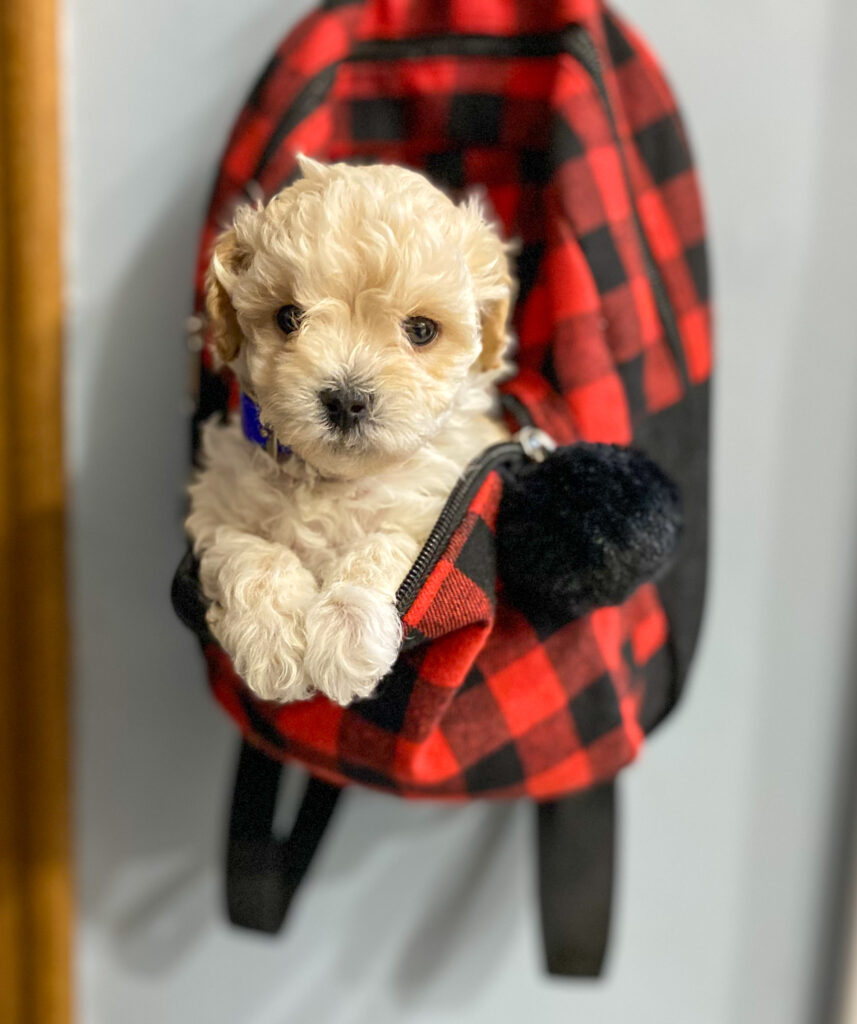
Pros and Cons of Teacup Maltipoos
Teacup Maltipoos, a tiny variation of the popular Maltipoo breed, are beloved for their adorable size, affectionate nature, and hypoallergenic coats. However, their miniature stature comes with challenges, including fragile health and special care needs. Below is an in-depth look at their benefits and drawbacks.
Pros of Teacup Maltipoos
1. Small Size and Portability
✔ Perfect for Small Spaces – Teacup Maltipoos are ideal for apartment living, small homes, or owners who prefer a lap-sized companion.
✔ Easy to Travel With – Their tiny size allows them to fit in carriers, making them great travel companions for road trips or flights.
2. Adorable Appearance and Cuteness Factor of Teacup Maltipoo Puppies
✔ Forever Puppy Look – Teacup Maltipoos retain a puppy-like appearance even as adults, with their round faces, button noses, and fluffy coats.
✔ Instagram-Worthy – Their tiny, teddy bear-like appearance makes them highly photogenic and popular among social media influencers and dog lovers.
3. Loving and Affectionate Personality
✔ Strong Bond with Owners – Maltipoos are known for being incredibly affectionate and forming deep attachments with their humans.
✔ Great Companion Dogs – They thrive on companionship and love to cuddle, making them excellent emotional support animals.
4. Low Shedding and Hypoallergenic Qualities
✔ Great for Allergy Sufferers – Maltipoos have a low-shedding coat, reducing the amount of dander in the home.
✔ Easy to Maintain – With proper grooming, their soft, curly fur stays clean and manageable.
5. Intelligent and Trainable
✔ Quick Learners – Maltipoos inherit intelligence from their Poodle lineage, making them easy to train for basic commands and tricks.
✔ Great for First-Time Owners – Their eagerness to please and gentle temperament make them a good choice for beginners.
Cons of Teacup Maltipoos
1. Fragile Health and Size-Related Issues
✖ Delicate Bones and High Injury Risk – Due to their small size, teacup Maltipoos are prone to fractures and injuries from rough handling or accidental falls.
✖ Hypoglycemia (Low Blood Sugar) – Tiny breeds like the Teacup Maltipoo are susceptible to hypoglycemia, which can lead to lethargy, seizures, or even coma if not managed properly.
✖ Organ Development Issues – Their extremely small size can lead to underdeveloped organs, increasing the risk of heart, liver, and kidney problems.
2. High Maintenance and Special Care Needs
✖ Frequent Feeding Required – Because of their risk for hypoglycemia, they often require multiple small meals per day.
✖ Temperature Sensitivity – Teacup Maltipoos struggle to regulate body temperature and are highly sensitive to both hot and cold weather. They often need sweaters in winter and careful monitoring in the summer.
✖ Regular Grooming Needed – Their curly coats require frequent brushing, professional grooming, and regular trims to prevent matting.
3. Shorter Lifespan and Ethical Concerns
✖ High Veterinary Costs – Due to their delicate nature, teacup Maltipoos often require more frequent vet visits, which can be costly over time.
4. Separation Anxiety and Need for Constant Attention
✖ Extremely Dependent on Owners – Their affectionate nature means they don’t tolerate being alone for long periods and can develop separation anxiety.
✖ May Not Be Suitable for Busy Owners – If left alone too often, they may become stressed, leading to excessive barking, destructive behaviors, or depression.
5. Limited Compatibility with Small Children and Other Pets
✖ Not Ideal for Homes with Young Kids – Their tiny size makes them vulnerable to rough handling, accidental drops, or injuries from small children.
✖ Can Be Fragile Around Larger Dogs – While they can get along with other pets, they are at risk of getting injured if a larger dog plays too roughly.
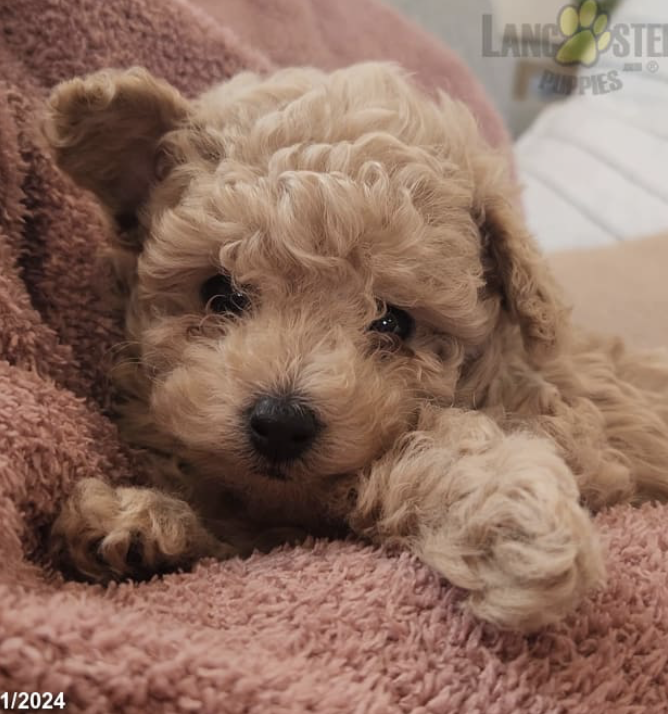
Is a Teacup Maltipoo Right for You?
Teacup Maltipoo dogs can be wonderful companions for the right owner. If you’re looking for a small, affectionate, and hypoallergenic dog and are prepared for the extra care they require, they can be an excellent choice. However, due to their fragile health, high-maintenance needs, and ethical concerns surrounding their breeding, they may not be the best fit for families with small children or owners who are frequently away from home.
If you’re considering a teacup Maltipoo, it’s crucial to research responsible breeders who prioritize health over size. Alternatively, a slightly larger Maltipoo may offer many of the same benefits with fewer health risks.
Caring for a Teacup Maltipoo Puppy
Owning a Teacup Maltipoo comes with responsibilities. Their small size makes them more delicate than larger dogs, so they require special attention in several areas.
Feeding and Nutrition
Because of their tiny size, Teacup Maltipoos need small, frequent meals to maintain stable blood sugar levels. Hypoglycemia (low blood sugar) is a common concern in toy breeds, so regular feeding is essential.
Feeding Tips:
- Choose high-quality dog food with protein, healthy fats, and essential nutrients.
- Divide meals into three to four small portions per day.
- Avoid human foods like chocolate, grapes, and onions, which are toxic to dogs.
- Provide fresh water at all times to keep them hydrated.
Grooming and Coat Care
Teacup Maltipoos have soft, wavy, or curly coats that require regular grooming. Since they are low-shedding, they need brushing to prevent tangles and matting.
Grooming Routine:
- Brush their coat daily to keep it soft and tangle-free.
- Bathe them every three to four weeks with a gentle dog shampoo.
- Trim their hair every six to eight weeks to maintain a tidy appearance.
- Clean their ears weekly to prevent infections.
- Brush their teeth daily to prevent dental issues.
Exercise and Playtime for a Teacup Maltipoo Puppy
Even though they are small, Teacup Maltipoos need regular exercise to stay healthy. They don’t require long walks, but short daily outings and indoor playtime are essential.
Activity Ideas:
- Short walks around the neighborhood.
- Indoor play with small, lightweight toys.
- Mental stimulation with puzzle toys and treat-dispensing games.
- Supervised socialization with other small dogs.
Health Considerations
Teacup Maltipoos are adorable, but their small size makes them prone to certain health issues. Responsible breeders take steps to produce healthy puppies, but owners should be aware of potential concerns.
Common Health Problems:
- Hypoglycemia – Small dogs can experience low blood sugar, leading to weakness and tremors. Regular meals help prevent this.
- Patellar Luxation – A knee condition that can cause discomfort or limping. Regular vet check-ups help monitor joint health.
- Dental Problems – Tiny mouths mean crowded teeth, making them prone to plaque buildup and gum disease. Daily brushing is essential.
- Collapsed Trachea – A condition that causes breathing issues, often triggered by pulling on a collar. Use a harness instead of a leash around the neck.
- Heart Problems – Some small breeds are prone to heart disease, so regular vet check-ups are important.
Training and Socialization
Teacup Maltipoos are intelligent and eager to please, making training enjoyable. However, their small size can lead to spoiled behavior if owners don’t set clear boundaries.
House Training
Potty training a Teacup Maltipoo takes patience and consistency. Because of their tiny bladders, they need frequent bathroom breaks. Consider using pee pads or a designated indoor potty area if you live in an apartment.
Crate Training
A crate provides a safe space for your Maltipoo and helps with house training. Choose a small, comfortable crate with soft bedding. Use positive reinforcement to make it a cozy retreat rather than a punishment.
Basic Commands
Teaching basic commands like sit, stay, come, and leave it makes life easier for both you and your dog. Keep training sessions short and rewarding to maintain their interest.
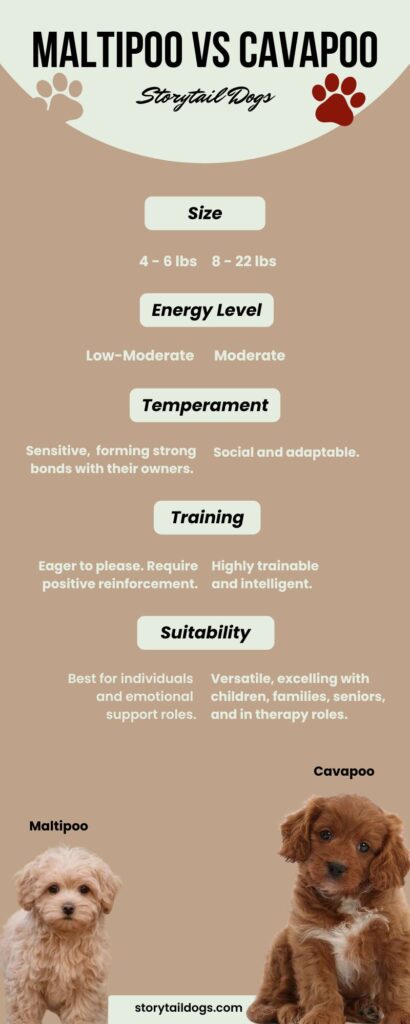
Finding a Teacup Maltipoo Puppy
If you’re ready to welcome a Teacup Maltipoo into your home, finding a responsible breeder is crucial. Because of their popularity, some breeders prioritize size over health, leading to puppies with genetic health issues.
Choosing a Maltipoo Breeder
Look for a breeder who:
- Focuses on health and temperament rather than extreme small size.
- Performs genetic health testing on the parents.
- Raises puppies in a home environment for proper socialization.
- Provides a health guarantee and vet records.
Avoid breeders who refuse to answer questions or seem more interested in making a sale than ensuring a good match.
Is a Teacup Maltipoo Puppy Right for You?
Teacup Maltipoos are loving, intelligent, and playful companions, but they are not the right fit for every household. Their small size makes them better suited for homes without large pets or very young children who might handle them too roughly.
They require time, attention, and regular vet care to stay healthy. If you want a tiny dog with a big heart and can commit to their needs, a Teacup Maltipoo can bring endless joy and companionship.
History and Origin of the Maltipoo Dog
The Maltese and Poodle: A Brief Background
The Maltese and Poodle, two ancient breeds, contribute unique qualities to the Maltipoo’s temperament and appearance.
The Maltese, a toy breed with a history dating back over 2,000 years, was a favorite among aristocrats in ancient Greece and Rome. These small, white dogs were known for their affectionate nature and elegant, flowing coats. Over centuries, breeders refined the Maltese into a compact companion with a lively and loving personality.
The Poodle, originally bred as a water retriever in Germany, later became a symbol of refinement in France. The breed’s intelligence, trainability, and hypoallergenic coat made it highly desirable. While standard Poodles were used for retrieving, the Miniature and Toy Poodles were bred down in size to serve as companions. These smaller Poodles retained the breed’s sharp intellect and affectionate nature.
Both the Maltese and Poodle share traits that make them ideal companions: intelligence, low-shedding coats, and affectionate temperaments. The Maltipoo inherits these qualities, making it a highly sought-after hybrid.
How the Maltipoo Dog Became a Popular Designer Breed
The Maltipoo originated in the United States, where breeders sought to create a small, hypoallergenic companion with the best qualities of both parent breeds. The goal was to combine the Maltese’s sweet, people-oriented nature with the Poodle’s intelligence and low-allergen coat.
By the late 1990s and early 2000s, designer dog breeds were rising in popularity. The Maltipoo quickly gained attention, especially among city dwellers and allergy sufferers. Families and individuals looking for a friendly, low-maintenance companion found the breed ideal. Maltipoos became favorites among celebrities, further increasing their appeal.
Unlike purebred dogs, Maltipoos are not recognized by major kennel clubs like the AKC (American Kennel Club). However, their popularity continues to grow due to their affectionate nature and adaptability.
The Rise of Teacup-Sized Maltipoos and Ethical Considerations
As demand for small dogs increased, breeders began producing even tinier versions of Maltipoos. The teacup Maltipoo emerged through selective breeding, where the smallest puppies from each litter were paired to create a micro-sized version of the breed.
While teacup Maltipoos are undeniably cute, ethical concerns surround their breeding. Many breeders achieve their small size by:
- Breeding runt puppies that may have underlying health issues.
- Using questionable breeding practices, including early separation from the mother.
- Prioritizing extreme miniaturization over health and longevity.
Because of their fragile bones, tiny organs, and higher risk of genetic conditions, teacup Maltipoos require specialized care. Responsible breeders focus on health and temperament rather than extreme size. Potential owners should research thoroughly to ensure they support ethical breeding practices.
Despite these concerns, the teacup Maltipoo remains a popular choice for those looking for an ultra-small, affectionate companion. However, many experts recommend a toy-sized Maltipoo (5-10 lbs) as a healthier alternative that still provides all the charm of a teacup without the increased health risks.
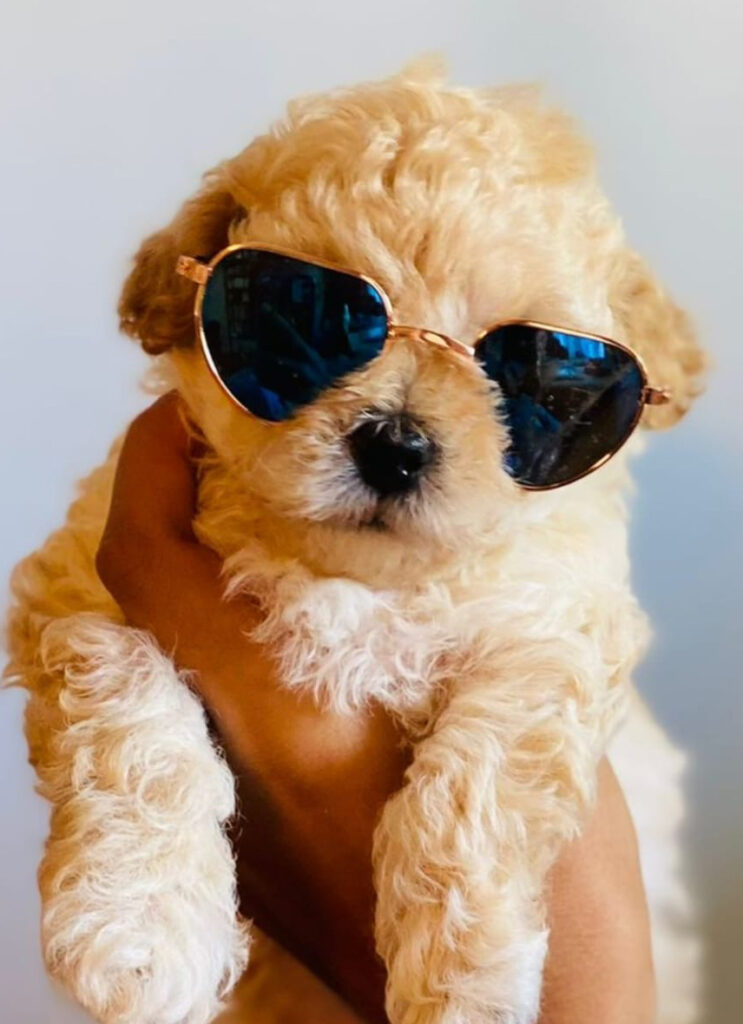
What Makes a Teacup Maltipoo Different from a Regular Maltipoo?
Size Comparison: Teacup vs. Toy vs. Miniature Maltipoos
Maltipoos come in different sizes, largely based on the Poodle parent’s size. While no official kennel club recognizes the teacup, toy, or miniature classifications, breeders and owners use these terms to describe different size variations.
- Teacup Maltipoo – The smallest of the three, a teacup Maltipoo typically weighs under 5 pounds and stands less than 8 inches tall at the shoulder. Some can be as tiny as 3-4 pounds, making them one of the most delicate designer breeds.
- Toy Maltipoo – This size is more common and healthier. A toy Maltipoo weighs between 5 and 10 pounds and stands 8-10 inches tall. They are still compact but sturdier than their teacup counterparts.
- Miniature Maltipoo – The largest of the three, a miniature Maltipoo can weigh between 10 and 20 pounds and stand up to 14 inches tall. These dogs typically come from a Miniature Poodle parent rather than a Toy Poodle.
Teacup Maltipoos are specifically bred for extreme smallness, often through repeated breeding of the smallest puppies (runts). While their tiny size makes them highly desirable, it also brings significant health concerns.
Differences in Lifespan, Health Risks, and Temperament
Lifespan
A standard Maltipoo (toy or miniature) typically lives between 12 and 16 years with proper care. However, teacup Maltipoos have shorter lifespans due to their increased health risks. Many live between 7 and 12 years, though some may reach their teenage years with excellent care.
Health Risks
Teacup Maltipoos face many health challenges due to their tiny size. Some of the most common issues include:
- Hypoglycemia (low blood sugar) – Small dogs have difficulty regulating blood sugar, leading to weakness, seizures, and even death if untreated.
- Fragile bones – Their tiny frame makes them prone to fractures from minor falls or rough handling. Jumping off furniture can cause serious injuries.
- Heart and organ issues – Due to their miniature size, teacup Maltipoos often have underdeveloped organs, leading to heart, liver, and kidney problems.
- Dental problems – Small jaws result in overcrowded teeth, which increases the risk of gum disease and tooth loss.
- Tracheal collapse – Weak cartilage in the windpipe can cause breathing difficulties, which worsens with excitement or exercise.
Responsible owners must take extra precautions to keep teacup Maltipoos safe. They require regular vet checkups, proper nutrition, and careful handling to minimize health risks.
Temperament
Despite their small size, teacup Maltipoos retain the playful, affectionate, and social nature of standard Maltipoos. However, their fragility makes them less suited for families with young children or large pets. They thrive in quiet households where they receive plenty of attention.
Some teacup Maltipoos may also be more anxious or nervous due to their delicate build. They can become easily startled and require gentle, positive reinforcement training to build confidence.
Common Misconceptions About Teacup Breeds
“Teacup Maltipoos are healthier than regular Maltipoos because they eat less and need less exercise.”
Smaller dogs may eat less, but they require frequent, balanced meals to prevent hypoglycemia. They also need mental stimulation and light exercise to stay healthy.
“A teacup Maltipoo will stay a puppy forever.”
Many people believe teacup dogs remain tiny and behave like puppies forever. While they stay small, they still grow into adult dogs and require the same training, socialization, and care as any other breed.
“Teacup Maltipoos are easy to care for because they don’t need much space.”
While their small size makes them suitable for apartments, they require consistent care, specialized nutrition, and regular vet visits. They are more fragile than larger dogs, making their care more demanding, not less.

How to Choose a Responsible Teacup Maltipoo Breeder
Finding a responsible breeder is essential when looking for a healthy, well-adjusted teacup Maltipoo. Due to their tiny size, these dogs require careful breeding practices to avoid serious health issues. Unfortunately, many breeders prioritize size over health, leading to fragile, sickly puppies. Knowing how to identify ethical breeders will help ensure your puppy has the best possible start in life.
Warning Signs of Unethical Breeding
Not all breeders follow ethical practices, Look for these red flags when researching a breeder:
- Extremely small puppies – If a breeder advertises Maltipoos weighing under 3 pounds as adults, they are likely breeding runts repeatedly or underfeeding puppies to stunt their growth. Both practices result in serious health problems.
- Lack of health records – Ethical breeders conduct health screenings on parent dogs for genetic conditions, heart issues, and patellar luxation. If a breeder refuses to provide proof, they may be hiding hereditary illnesses.
- No health guarantees – Reputable breeders offer a health guarantee covering genetic conditions. If a breeder does not provide one, they may not stand behind the quality of their puppies.
- No interest in screening buyers – A responsible breeder asks questions about your lifestyle, home environment, and experience with small dogs. If they are willing to sell to anyone with cash, they prioritize profit over the puppy’s well-being.
- Poor living conditions – Ethical breeders raise puppies in clean, stimulating environments where they receive proper socialization. If puppies are kept in cages or dirty areas, they may come from a substandard breeder.
Questions to Ask a Breeder Before Purchasing
A good breeder welcomes questions and provides honest, transparent answers. Before committing to a teacup Maltipoo, ask the following:
1. Can I meet the puppy’s parents?
Seeing the parents helps determine the puppy’s expected size, temperament, and health. If the breeder refuses, they may be hiding poor conditions or unhealthy breeding stock.
2. What health tests have been done on the parents?
Responsible breeders test for progressive retinal atrophy (PRA), luxating patellas, heart issues, and hypoglycemia risk. If no testing has been done, walk away.
3. How big do you expect this puppy to grow?
A responsible breeder gives a realistic size estimate. If they guarantee an adult weight under 3 pounds, they are likely prioritizing extreme smallness over health.
4. How do you socialize your puppies?
Early socialization helps puppies become well-adjusted adults. Good breeders expose puppies to household noises, handling, grooming, and different people from an early age.
5. What do you feed the puppies?
Teacup Maltipoos require high-quality, nutrient-dense food to prevent low blood sugar. Ethical breeders provide a detailed diet plan and guidance on feeding schedules.
6. What is included in the purchase?
A responsible breeder sends puppies home with:
- Vaccination and deworming records
- A health guarantee
- A sample of their current food
- A comfort item (such as a blanket with their mother’s scent)
- Care instructions specific to small-breed puppies
The Importance of Health Testing and Early Socialization
Health Testing: Preventing Genetic Issues
Since teacup Maltipoos are prone to luxating patellas, hypoglycemia, and heart issues, responsible breeders screen parent dogs before breeding. Health testing helps reduce the risk of genetic disorders, ensuring healthier puppies.
Early Socialization: Building Confidence
Teacup Maltipoos can be more anxious due to their small size. Proper socialization helps them develop confidence. A good breeder:
- Exposes puppies to new sights, sounds, and people
- Handles them daily to get them comfortable with grooming and vet visits
- Encourages gentle play and interaction with other dogs and people
By choosing a breeder who prioritizes health and temperament over extreme smallness, you increase the chances of bringing home a happy, well-adjusted puppy.
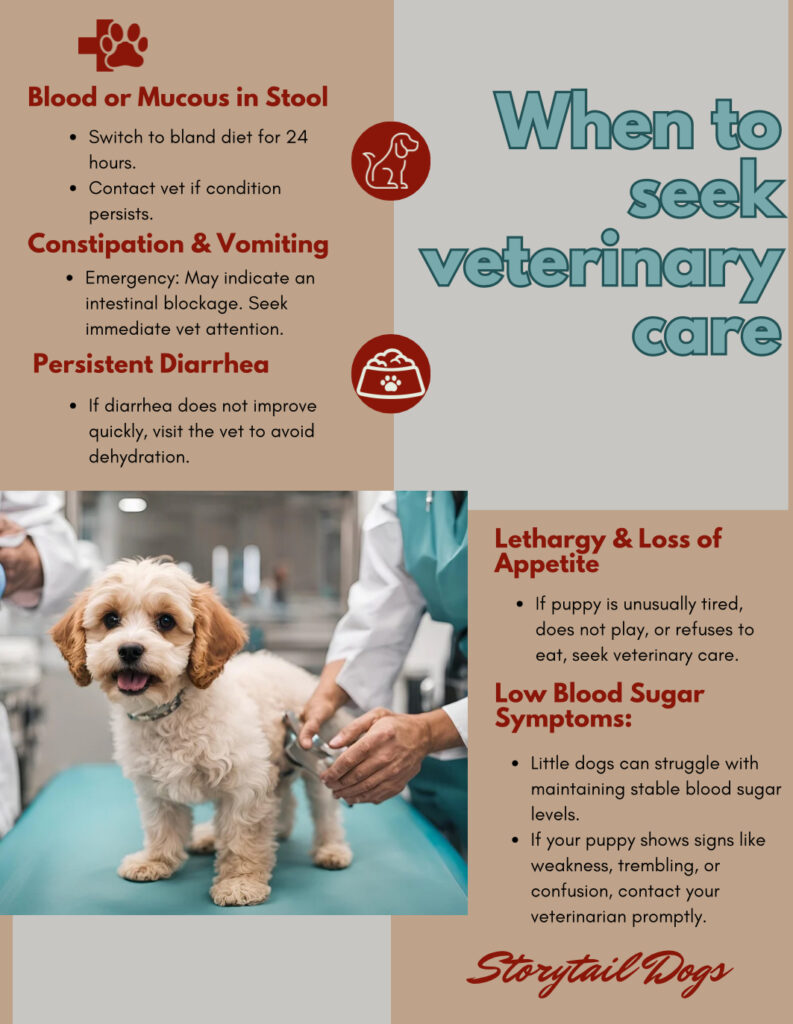
Caring for a Teacup Maltipoo: Tips for First-Time Owners
Teacup Maltipoos require specialized care due to their tiny size and delicate structure. First-time owners must understand their unique needs, including proper diet, exercise, grooming, and home safety. With the right approach, these small dogs can thrive and bring endless joy to their owners.
Diet and Nutrition: Small but Frequent Meals
Hypoglycemia (low blood sugar) poses one of the greatest risks to teacup Maltipoos. Due to their fast metabolism and small stomachs, they require small, frequent meals throughout the day.
- Meal Frequency – Feed a teacup Maltipoo four to six small meals daily to maintain stable blood sugar levels.
- High-Quality Food – Choose a small-breed puppy formula rich in protein and healthy fats. Avoid foods with excessive fillers like corn or soy.
- Healthy Snacks – Offer nutritious treats such as small pieces of cooked chicken, scrambled eggs, or freeze-dried liver.
- Water Intake – Keep fresh, clean water available at all times to prevent dehydration.
- Emergency Care – If a puppy shows signs of hypoglycemia (weakness, trembling, or lethargy), rub a small amount of honey or Karo syrup on its gums and seek veterinary help immediately.
Exercise Recommendations: Gentle Playtime Over Intense Activity
Although playful and energetic, teacup Maltipoos cannot handle intense exercise. Their tiny bones and fragile joints make high-impact activities risky.
- Short Play Sessions – Engage in five to ten minutes of gentle play several times a day. Tug-of-war, chasing a soft toy, or hide-and-seek works well.
- Avoid Jumping – Jumping from furniture, climbing stairs, or rough play with larger dogs can cause serious injuries. Always supervise interactions.
- Indoor-Friendly Activities – Due to their small size, teacup Maltipoos can burn energy indoors with interactive toys, tunnels, or short training sessions.
- Outdoor Caution – If taking them outside, choose soft grassy areas and avoid extreme temperatures. Cold weather affects them quickly, and heat exhaustion can set in fast.
Grooming Tips: Keeping Their Coat, Eyes, and Teeth Healthy
Teacup Maltipoos require regular grooming to keep their coat clean and prevent common small-breed health issues.
Coat Care
- Brush their fur at least three times a week to prevent matting.
- Use a gentle, moisturizing shampoo during baths to avoid skin irritation.
- Keep the fur trimmed around the eyes, paws, and sanitary areas.
Tear Stain Removal
- Clean the area under the eyes daily with a soft, damp cloth or pet-safe wipes.
- Use a stainless steel or ceramic water bowl to reduce mineral buildup, which worsens staining.
- If tear stains persist, consult a vet to rule out allergies or blocked tear ducts.
Dental Hygiene
- Small breeds like teacup Maltipoos develop dental issues easily. Brush their teeth three to five times per week using dog-safe toothpaste.
- Provide dental chews or toys to help reduce tartar buildup.
- Schedule regular vet cleanings to prevent gum disease.

How to Puppy-Proof Your Home for a Teacup Maltipoo
Because of their tiny size and fragile bodies, teacup Maltipoos need a safe home environment. Even minor hazards pose serious risks.
- Block Small Spaces – Puppies squeeze into small gaps behind furniture, under cabinets, or inside recliners. Use barriers to keep them safe.
- Secure Electrical Cords – Teething puppies may chew on wires. Hide or cover cords to prevent electric shocks.
- Cushion High Surfaces – If your Maltipoo jumps off a couch or bed, it can fracture a bone. Use pet stairs or a ramp for safe access.
- Avoid Toxic Plants – Common houseplants like lilies, pothos, and philodendrons can be toxic. Keep them out of reach.
- Use Puppy-Safe Cleaning Products – Many household cleaners contain chemicals dangerous to dogs. Opt for pet-safe alternatives.
Caring for a teacup Maltipoo requires extra attention, but the effort ensures a healthy, happy companion. With the right diet, exercise, grooming, and home setup, these tiny dogs can live long, fulfilling lives.
How to Prevent Common Health Issues in Teacup Maltipoos
Teacup Maltipoos may look delicate and adorable, but their tiny size comes with a higher risk of health problems. Many small dog breeds face similar challenges, but teacup-sized dogs are even more vulnerable. Knowing the most common health concerns helps owners take preventative measures and provide the best possible care.
1. Hypoglycemia (Low Blood Sugar)
Teacup Maltipoos burn energy quickly due to their small size and fast metabolism. If they go too long without eating, their blood sugar can drop to dangerously low levels. This condition causes weakness, trembling, disorientation, or even seizures.
How to Prevent Hypoglycemia:
- Feed small meals four to six times a day instead of two large meals.
- Choose high-quality, protein-rich food to sustain energy levels.
- Always have a small amount of honey or Karo syrup on hand in case of an emergency.
- If your puppy becomes lethargic or unresponsive, rub honey on their gums and contact a vet immediately.
2. Fragile Bones and Joint Issues
Due to their tiny frame and delicate bones, teacup Maltipoos are prone to fractures and joint conditions like luxating patella (where the kneecap slips out of place). A small jump from a couch or a rough play session with a larger pet can cause serious injuries.
How to Prevent Bone and Joint Injuries:
- Always support their body when picking them up and never let them jump from high surfaces.
- Use pet stairs or ramps for beds, couches, and cars.
- Avoid intense exercise or activities that put stress on their joints.
- Provide calcium and joint-supporting supplements (if recommended by a vet).
3. Collapsing Trachea
A weak or malformed trachea (windpipe) can lead to breathing difficulties, chronic coughing, and a honking sound when excited or stressed. This condition worsens with excessive pulling on a collar or exposure to irritants like smoke or strong fragrances.
How to Protect the Trachea:
- Use a harness instead of a collar to prevent pressure on the neck.
- Avoid excessive excitement, especially in hot weather, which can cause breathing difficulties.
- Keep the home free of smoke, dust, and strong perfumes.
4. Heart Problems
Like many small breeds, teacup Maltipoos have a higher risk of heart disease and murmurs. Symptoms include fatigue, coughing, and difficulty breathing. Heart disease often develops with age but can be managed with early detection and proper care.
How to Support Heart Health:
- Schedule regular vet checkups to catch early signs of heart disease.
- Provide a balanced diet with omega-3 fatty acids to support heart function.
- Maintain a healthy weight to reduce strain on the heart.
- Limit excessive exercise, especially in extreme heat or cold.
5. Dental Disease
Teacup Maltipoos have small mouths, making them more susceptible to crowded teeth, plaque buildup, and gum infections. Without regular dental care, they may develop bad breath, tooth loss, or painful infections.
How to Prevent Dental Problems:
- Brush their teeth three to five times per week using dog-safe toothpaste.
- Provide dental chews or crunchy kibble to reduce plaque buildup.
- Schedule annual professional cleanings with a veterinarian.
6. Digestive Sensitivities
Small stomachs make teacup Maltipoos prone to vomiting, diarrhea, and food intolerances. Sudden diet changes or rich, fatty foods can upset their digestion.
How to Protect Digestive Health:
- Feed a consistent, high-quality diet suited for small breeds.
- Introduce new foods gradually to avoid stomach upset.
- Monitor for food allergies (itchy skin, ear infections, or chronic digestive issues).
- Provide a probiotic supplement to support gut health if recommended by a vet.
7. Temperature Sensitivity
Teacup Maltipoos struggle to regulate body temperature. Cold weather can lead to hypothermia, while hot weather increases the risk of heatstroke.
How to Keep Them Comfortable:
- In winter, dress them in sweaters or jackets and limit outdoor time.
- In summer, avoid walks during peak heat and provide plenty of fresh water.
- Keep their bed away from drafty windows or air conditioning vents.
Teacup Maltipoos require extra care and attention to stay healthy. By understanding their unique health risks and taking proactive steps, owners can ensure their tiny companions live long, happy lives. Regular vet visits, a safe home environment, and a balanced routine will help prevent many common health problems.
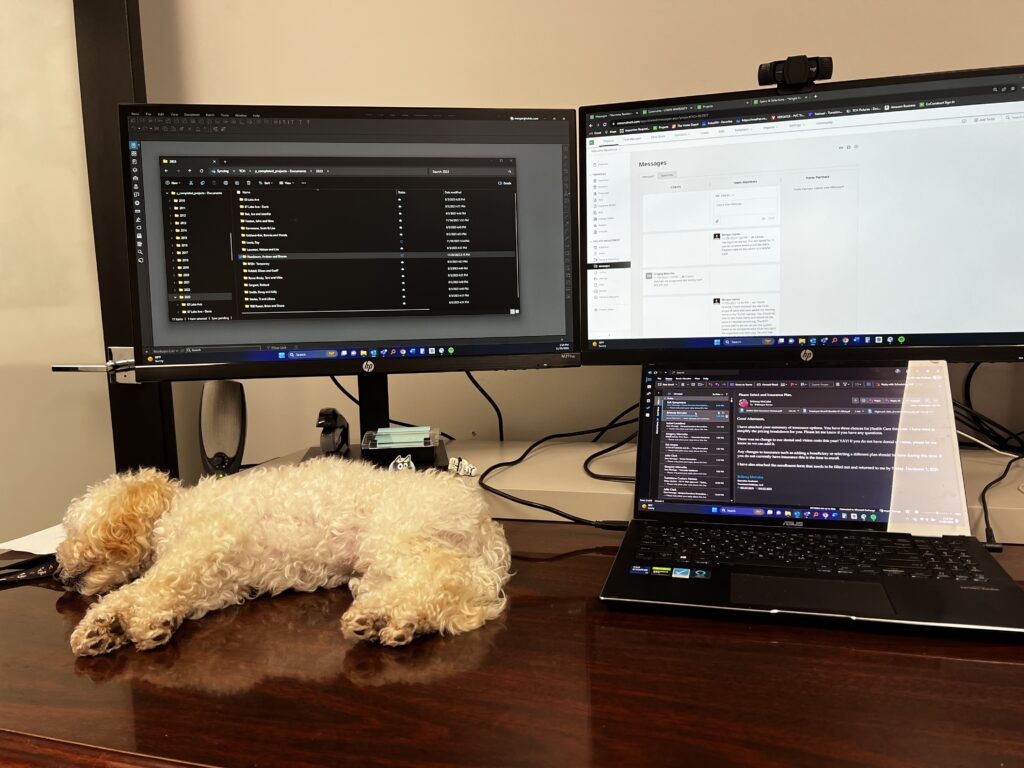
Teacup Maltipoos and Apartment Living
Teacup Maltipoos thrive in small living spaces, making them an ideal choice for apartment dwellers. Their tiny size means they don’t need a large yard to stay happy, but they do require mental stimulation, training, and regular care to ensure a well-balanced life. Here’s how to keep a teacup Maltipoo happy and healthy in an apartment setting.
1. Why Teacup Maltipoos Are Perfect for Apartment Life
Many dog breeds struggle in small spaces, but teacup Maltipoos adapt well to compact environments. Their small stature means they don’t require much room to roam, and they can get most of their exercise indoors. Unlike larger or high-energy breeds, teacup Maltipoos have moderate activity needs that can be met with short play sessions, indoor fetch, and occasional walks.
Other reasons why they make great apartment pets include:
- Minimal barking (with proper training): They don’t have a strong guarding instinct, so they usually bark only when necessary.
- Lightweight and portable: Their small size makes them easy to carry when using stairs or elevators.
- Low-shedding coat: They don’t leave fur all over furniture or carpets, making cleanup easier.
While they thrive in apartments, they still need routine play and social interaction to prevent boredom or separation anxiety.
2. Keeping a Teacup Maltipoo Entertained Indoors
Even though teacup Maltipoos don’t require a large yard, they still need regular exercise and mental stimulation to stay happy. An apartment offers plenty of ways to keep them engaged without taking up much space.
Here are some indoor activities to keep them entertained:
- Puzzle toys and treat dispensers: These challenge their minds and keep them occupied when left alone.
- Mini obstacle courses: Set up small tunnels, step stools, or cushions to create an indoor agility course.
- Short training sessions: Teaching new tricks or practicing commands stimulates their brain and strengthens the bond between owner and dog.
- Interactive playtime: Games like hide-and-seek or fetch in a hallway provide exercise without needing a yard.
- Window watching station: A comfy bed near a window can keep them entertained for hours, watching birds or passing cars.
Since teacup Maltipoos are prone to separation anxiety, leaving them alone for long hours without entertainment can lead to destructive behaviors. Providing toys, background noise (like soft music or TV), and a comfortable resting spot can help ease stress when they’re alone.
3. Best Potty-Training Methods for Teacup Maltipoos
Due to their tiny bladders, teacup Maltipoos may need frequent potty breaks. Training them in an apartment setting requires patience and consistency, but with the right approach, they can learn quickly.
Indoor Potty Training (Pee Pads & Litter Boxes)
Many apartment owners choose indoor potty solutions since teacup Maltipoos can struggle with extreme temperatures. Pee pads and dog litter boxes provide a convenient indoor bathroom option.
- Pros:
- Useful for puppies, senior dogs, and those left alone for long hours.
- Protects against accidents when outdoor walks aren’t possible.
- Great for cold, rainy, or snowy weather.
- Cons:
- Some dogs develop a habit of using rugs or carpets if not properly trained.
- Requires frequent pad changes to maintain cleanliness.
Outdoor Potty Training
If an owner prefers outdoor training, establishing a routine schedule is essential. Small breeds need to go every 2-3 hours, especially as puppies.
- Steps for successful outdoor training:
- Take them out after eating, drinking, waking up, or playing.
- Use consistent verbal cues like “go potty” to reinforce the habit.
- Reward with treats and praise immediately after they go outside.
- Establish a designated potty spot to help them learn where to go.
Some owners use a combination approach, training their dog to go outside but also providing pee pads as a backup for times when outdoor trips aren’t possible.
Teacup Maltipoos make excellent apartment pets, but they still require mental stimulation, training, and a consistent potty routine to thrive. Their small size allows them to adapt well to compact living, but owners must ensure they get enough exercise, interaction, and structure to stay happy and well-adjusted. With the right approach, a teacup Maltipoo can live comfortably and joyfully in an apartment for many years.

Training and Socialization for Teacup Maltipoos
Teacup Maltipoos are delightful, intelligent, and affectionate dogs, but training and socializing them can present unique challenges due to their small size. With the right approach, however, you can raise a well-behaved, confident, and socially balanced dog. Let’s explore the key aspects of training and socialization for Teacup Maltipoos.
1. Are Teacup Maltipoos Easy to Train?
Teacup Maltipoos are generally intelligent and eager to please, making them relatively easy to train in terms of learning basic commands. However, their small size and temperament can present challenges:
- Pros of Training Teacup Maltipoos:
- Quick Learners: These dogs tend to pick up on commands and routines quickly, making training sessions enjoyable for both you and your puppy.
- Desire to Please: Maltipoos are known for their affectionate nature, and they love pleasing their owners. This makes positive reinforcement techniques (like treats and praise) highly effective.
- Adaptable: Teacup Maltipoos often adapt well to different environments and routines, so they tend to learn house rules and boundaries fairly quickly.
- Challenges of Training a Tiny Dog:
- Short Attention Span: Due to their small size and energetic nature, Teacup Maltipoos may have shorter attention spans. Training sessions should be kept short and engaging to avoid frustration.
- Stubbornness: While they are intelligent, some Teacup Maltipoos can exhibit a bit of stubbornness, especially if they sense they can get away with certain behaviors.
- Size Issues: Their small size means they’re less tolerant of rough handling or overly firm corrections, which can make training challenging. Gentle, consistent methods work best with these delicate dogs.
2. Best Socialization Practices for Preventing Fearfulness
Socialization is crucial for any dog, but it is especially important for Teacup Maltipoos due to their small size. Proper socialization helps prevent fearfulness and anxiety around new people, environments, and other animals. Here are some best practices for socializing your Teacup Maltipoo:
- Early Exposure: Start socializing your puppy as early as possible, ideally between 8 and 16 weeks of age. Early exposure to different people, environments, and other dogs helps your puppy feel comfortable and confident in various situations.
- Positive Reinforcement: Always use positive reinforcement when exposing your Teacup Maltipoo to new experiences. Reward calm behavior with treats and praise to build positive associations with new situations. This can prevent your dog from becoming fearful or anxious.
- Introduce Different Environments: Take your Teacup Maltipoo on walks to different places, such as parks, busy streets, and dog-friendly stores. Gradually expose your dog to more stimulating environments to help them become well-rounded and confident.
- Introduce Other Dogs and People: Socializing with other dogs and people is vital to help Teacup Maltipoos become well-mannered and confident in public spaces. Ensure that introductions to new dogs are slow and controlled, as some Teacup Maltipoos can be intimidated by larger dogs.
- Control Overwhelm: Be mindful not to overwhelm your Teacup Maltipoo with too much too soon. Gradually increase the complexity and intensity of their socialization experiences. Let your dog approach new experiences at their own pace.
3. Overcoming Small Dog Syndrome in Teacup Maltipoo Puppies
Small Dog Syndrome refers to a set of behaviors commonly exhibited by small breed dogs, including excessive barking, bossiness, and sometimes aggression. Teacup Maltipoos can fall into this pattern if not properly trained and socialized. Here’s how to avoid or correct these behaviors:
- Preventing Excessive Barking: Teacup Maltipoos can be quite vocal, especially if they feel threatened or want attention. Prevent excessive barking by teaching your puppy the “quiet” command early on. Use consistent positive reinforcement when your puppy stops barking, and avoid rewarding barking behavior by giving attention when they’re noisy.
- Limit Excessive Coddling: Although it’s tempting to spoil your tiny Teacup Maltipoo, excessive coddling can contribute to small dog syndrome. Ensure your dog learns boundaries and knows that barking or misbehaving won’t earn them attention.
- Avoiding Bossiness: Teacup Maltipoos can become overly bossy or dominant if they’re not trained to respect authority. It’s important to establish yourself as the leader early in your puppy’s life. Use consistent rules, commands, and expectations to ensure they understand their place in the household.
- Firm but Gentle Leadership: As a small dog, Teacup Maltipoos might push boundaries more than larger breeds, but it’s essential to avoid allowing them to become “in charge.” Practice consistent commands and reinforce desired behaviors through positive reinforcement.
- Encouraging Calm Behavior: Help your Teacup Maltipoo understand when it’s appropriate to be calm and when it’s okay to be playful or active. Rewarding calm behavior helps discourage over-excitement and hyperactivity. Practicing calmness during playtime and transitions between activities can build a well-behaved dog.
4. Summary of Training Teacup Maltipoos
Training and socializing a Teacup Maltipoo requires patience and consistency, but with the right approach, they can become well-mannered and confident companions. Here’s a quick summary of key points:
- Training: Teacup Maltipoos are intelligent and eager to please, but they may be prone to short attention spans and stubbornness. Use positive reinforcement techniques and keep training sessions short and fun.
- Socialization: Early socialization is crucial to prevent fearfulness. Expose your dog to different people, animals, and environments gradually, and always reward positive behavior.
- Small Dog Syndrome: Prevent excessive barking and bossiness by establishing firm boundaries, using positive reinforcement, and practicing calm behavior in different situations.
With dedication and consistency, your Teacup Maltipoo can grow into a confident, well-behaved, and loving companion, making for a happy and fulfilling relationship.

How Much Does a Teacup Maltipoo Cost?
Owning a Teacup Maltipoo comes with several costs beyond just the initial price. From vet visits to grooming and unexpected medical bills, it’s important to plan for both the anticipated and unanticipated expenses of owning one of these tiny, lovable companions. Let’s break down the costs involved in owning a Teacup Maltipoo.
1. Initial Purchase Price
The initial cost of purchasing a Teacup Maltipoo is typically between $3,500 and $12,000. This price range can vary based on several factors:
- Breeder Reputation: Reputable breeders who conduct health screenings and provide early socialization typically charge more.
- Pedigree and Lineage: Maltipoos with high-quality genetics, including parent dogs with champion lineage, tend to be more expensive.
- Coat Color and Size: Certain coat colors or smaller sizes may raise the price, especially if they are in higher demand.
If you’re purchasing from a responsible breeder, you’ll likely pay a higher upfront price, but you’re also ensuring that your puppy has been raised with the proper care and health checks.
2. Ongoing Expenses
Owning a Teacup Maltipoo requires regular financial commitment to ensure they stay healthy and happy. The ongoing expenses include:
- Vet Visits: Regular check-ups are essential for your puppy’s health, especially for a Teacup Maltipoo, which may be more prone to specific health issues due to their small size. Vet visits can cost anywhere from $50 to $200 per visit, depending on the type of visit and your location. Additionally, vaccinations and preventive care like flea and tick treatments can add to these costs.
- Food: Teacup Maltipoos require high-quality, small breed dog food to maintain their health. Expect to spend around $30 to $50 per month on dog food. This amount can vary depending on the brand, ingredients, and portion sizes based on your dog’s specific needs.
- Grooming: Teacup Maltipoos have long, silky coats that require regular grooming to keep them healthy and tangle-free. Professional grooming can cost between $40 and $75 every 4 to 6 weeks. This grooming includes bathing, nail trimming, ear cleaning, and coat maintenance. You may be able to do some grooming at home, but most owners prefer professional grooming to ensure a clean, healthy coat.
- Accessories: The additional accessories your Teacup Maltipoo needs, such as collars, leashes, beds, toys, and training tools, can add $100 to $300 annually. These items may need to be replaced periodically as your puppy grows.
3. Unexpected Medical Bills
One of the most significant considerations when owning a Teacup Maltipoo is the potential for unexpected medical bills. Due to their tiny size, Teacup Maltipoos are prone to certain health problems, such as:
- Dental Issues: Small dogs, including Teacup Maltipoos, often suffer from dental problems, including tooth decay and gum disease. Regular dental check-ups and cleanings can help prevent these issues but may come with additional costs.
- Heart Problems: Teacup Maltipoos may be at risk for heart conditions like heart murmurs or other congenital defects. Regular vet exams and tests can help detect these issues early, but they may lead to expensive treatments or medications down the line.
- Joint and Bone Issues: Their small size can also make them prone to joint and bone issues, such as luxating patellas (dislocated kneecaps). Surgery or physical therapy may be required in severe cases.
- Other Health Conditions: Teacup Maltipoos are also vulnerable to conditions like hypoglycemia (low blood sugar), respiratory issues, and digestive problems, which may require emergency visits and special treatments.
While these health issues aren’t guaranteed, they’re more likely in small breeds like the Teacup Maltipoo. Pet insurance can help manage these costs, but it’s essential to be prepared for the possibility of unexpected vet bills, which can add up quickly.
4. Insurance and Emergency Care
Given their small size and the potential for health issues, many owners choose to invest in pet insurance. A good pet insurance plan can cost anywhere from $20 to $50 per month, depending on the level of coverage. While insurance won’t eliminate all medical expenses, it can help reduce the financial burden of emergency care, surgeries, and ongoing treatments.
5. Summary of Costs
In summary, while the initial purchase price of a Teacup Maltipoo might seem manageable, it’s important to consider the ongoing and unexpected costs that come with owning one. Here’s a quick breakdown of the typical costs:
- Initial Purchase: $3,500 to $12,000
- Ongoing Expenses:
- Vet visits: $50 to $200 per visit
- Food: $30 to $50 per month
- Grooming: $40 to $75 every 4-6 weeks
- Accessories: $100 to $300 per year
- Unexpected Medical Bills: Can vary greatly, but plan for the possibility of expensive treatments or surgeries.
- Pet Insurance: $20 to $50 per month
Owning a Teacup Maltipoo is a financial commitment that goes beyond the purchase price. Be sure to plan for both the expected costs of care and the unexpected medical expenses that may arise to ensure a healthy, happy life for your little companion.
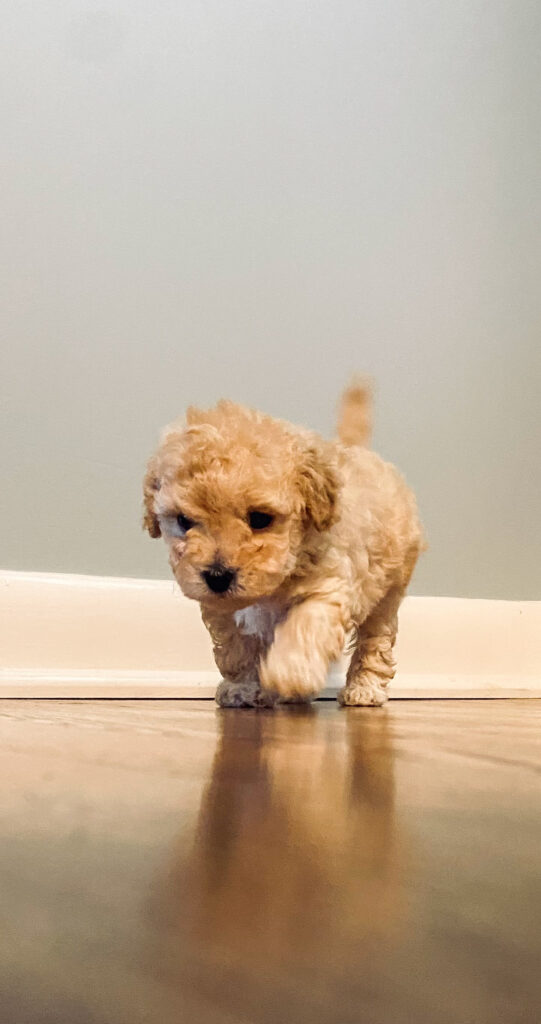
Ethical Alternatives to Teacup Maltipoos: Is a Slightly Larger Maltipoo a Better Choice?
When considering a Maltipoo, you may wonder if opting for a slightly larger version might be a better decision. While Teacup Maltipoos are charming and popular, they come with unique health risks that can make them harder to care for long-term. In contrast, slightly larger Maltipoos—often referred to as Toy Maltipoos—may offer a healthier alternative, more stability, and a better fit for your lifestyle. Let’s explore why a slightly larger Maltipoo might be a better choice and ethical alternatives like adoption from a rescue.
1. Why Toy-Sized Maltipoos May Be Healthier
While all Maltipoos, regardless of size, are typically healthy and affectionate, a slightly larger Maltipoo (Toy Maltipoo) often enjoys better health than a Teacup Maltipoo for several reasons:
- Stronger Genetics: Larger Maltipoos generally inherit stronger genetic traits from their parent breeds—Maltese and Toy Poodles. Smaller sizes, such as Teacup Maltipoos, are sometimes the result of breeding for size rather than for health, which can increase the likelihood of inherited health problems.
- Lower Risk of Fragile Health: Teacup Maltipoos are more prone to fragile health due to their small size. They can suffer from issues like hypoglycemia (low blood sugar), fragile bones, and even heart problems. Toy Maltipoos, which are a bit larger, tend to have a stronger immune system, making them more resilient overall.
- Easier to Manage Medical Needs: Smaller dogs often face unique challenges with anesthesia, dental health, and other medical procedures. Toy-sized Maltipoos, being just a bit bigger, are easier to handle in these situations and are less likely to experience some of the medical emergencies that are more common in Teacups.
Choosing a slightly larger Maltipoo can potentially reduce the frequency of costly vet visits and medical complications, leading to a happier and healthier dog over time.
2. Finding a Maltipoo That Fits Your Lifestyle Without Compromising Their Well-Being
When selecting a Maltipoo, it’s important to balance your desire for a particular size with the health and well-being of the dog. The key factors to consider include:
- Temperament and Personality: Smaller dogs like Teacup Maltipoos may be more prone to anxiety and fearfulness due to their delicate nature, which can make them challenging for first-time dog owners. A slightly larger Maltipoo, while still small and manageable, may have a calmer temperament that fits more easily into your home life.
- Physical Space and Activity Level: Consider your living environment and how active your lifestyle is. Toy Maltipoos can thrive in apartments and homes, provided they get enough exercise and mental stimulation. They’re typically easier to handle and more robust for families who might not have time to constantly supervise a fragile dog.
- Compatibility with Other Pets: If you already have other pets, especially larger dogs, a Toy Maltipoo may be more comfortable with them. Teacup Maltipoos, being more fragile, might feel intimidated or overwhelmed by larger animals and could easily get hurt if not monitored carefully.
Choosing a dog that fits your lifestyle helps ensure that both you and your pet can enjoy a happy, fulfilling life together without compromising the dog’s health.
3. Considering Adoption from a Maltipoo Rescue
Adopting from a Maltipoo rescue can be an ethical and rewarding way to bring a Maltipoo into your home. Many people are drawn to adopting from shelters, but adopting a Maltipoo specifically can be more difficult because of how well these dogs are cared for by their owners and breeders:
- Limited Availability for Adoption: Maltipoos are often well-cared-for pets, and owners tend to keep them for their entire lives. When people choose a Maltipoo from a breeder, they typically invest a lot of care in raising the dog, which leads to fewer dogs ending up in shelters.
- Ethical Breeding Practices: Responsible Maltipoo breeders often include a clause in their contracts requiring owners to return the dog to the breeder rather than surrendering it to a shelter. This ensures that the dog won’t end up in a rescue or shelter environment, and it also prevents unethical situations where dogs might be abandoned or mistreated.
- Rescue Challenges: While it is rare to find Maltipoos available for adoption at rescues, some rescue organizations occasionally have Maltipoos or similar mixed breeds in need of a home. However, because these dogs are well-loved, it is typically challenging to find one available for adoption.
If you’re committed to adopting a Maltipoo, be prepared for a potential wait. Check with reputable rescues and breeders who may have waiting lists or occasionally take in dogs that need to be rehomed for valid reasons.
4. Summary of Ethical Alternatives
Opting for a slightly larger Maltipoo can provide a healthier and more stable companion while still retaining the affectionate and playful nature of the breed. Here’s a quick summary of the key points:
- Healthier Choice: Slightly larger Maltipoos (Toy Maltipoos) tend to have fewer health risks and a stronger constitution than Teacup Maltipoos.
- Finding the Right Fit: It’s important to choose a Maltipoo that matches your lifestyle, considering factors like temperament, activity level, and compatibility with other pets.
- Adoption: While it’s rare to find a Maltipoo available for adoption due to how well they’re cared for and ethical breeding practices, it’s still worth exploring rescue organizations. Many breeders require the return of their dogs if rehoming is necessary, ensuring that these dogs don’t end up in shelters.
By thoughtfully considering the size and adoption options, you can ensure that you’re making the best choice for both you and your new furry friend’s well-being.
Final Thoughts
Teacup Maltipoos may be small, but their personalities are larger than life. With proper care, training, and love, they make wonderful companions for individuals and families alike. Whether you’re looking for a cuddle buddy, a playful friend, or a smart and trainable pet, this little dog has it all.
If you’re considering adding a Teacup Maltipoo to your family, do your research, find a responsible breeder, and prepare for a lifetime of love and companionship.
- Pet Maltipoo.com-“Teacup Maltipoo”- https://www.petmaltipoo.com/teacup-maltipoo
- Dogster-“Teacup Maltipoo: Info, Pictures, Care Guide & Traits”- https://www.dogster.com/dog-breeds/teacup-maltipoo
- ASPCA Pet Health Insurance-“All About Maltipoo”-https://www.aspcapetinsurance.com/resources/maltipoo/
Leave a Reply Cancel reply
Storytail Dogs
A Dog For Your Story. Focused on READ dogs, therapy dogs, and resilient family companions.
@storytaildogs
© StorytailDogs 2024. All rights reserved. | Legal |